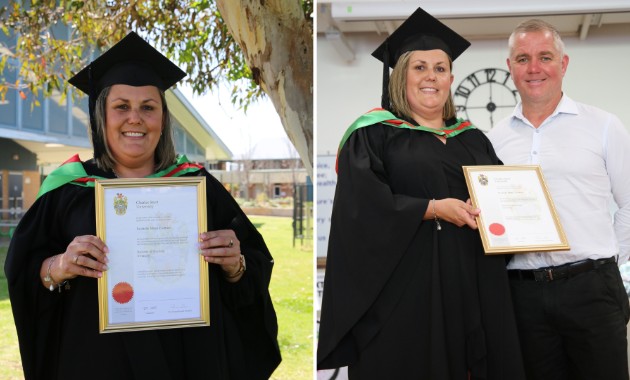So runs just one of many accolades for Charles Sturt University alumna Ms Mez Breeze, digital storytelling and virtual and augmented reality whiz.
Ms Breeze commenced a Bachelor of Social Science (Applied Social Science) in the Charles Sturt School of Humanities and Social Sciences in Bathurst in 1988, and graduated with Distinction in 1991, with a major in psychology and sub-major in sociology.
As one of seven children, as well as being a twin, Mary-Anne (Mez) Breeze started using the World Wide Web in 1994 to create experimental digital artworks and she hasn’t slowed since, becoming a leader in the field.
This is evidenced by her being awarded two major digital literature prizes in 2019: the Marjorie C Luesebrink Career Achievement Award which “…honors a visionary artist and/or scholar who has brought excellence to the field of electronic literature”; and the Queensland University of Technology Digital Literature Prize as part of the 2019 Queensland Literary Awards ( ‘… the world’s richest digital literacy prize’).
“I’m no novice when it comes to working, playing, and creating in 3D, virtual, and augmented environments,” Ms Breeze said.
“I’ve been true to my goal of relentlessly pursuing for 25 years arts practices that blur and muddy artistic distinctions, even at the expense of my own financial and traditional career advancement.”
Ms Breeze has received wide peer and industry recognition, including being invited to have a ‘career archive’ housed at Duke University’s David M Rubenstein Rare Book and Manuscript Library. There, her work has been acclaimed by academic peers as:
‘ … ground-breaking and important in the fields of electronic literature, internet art, and poetry more generally, and that access to the documentation of how these works were created will be important for future generations of scholars’. (Will Hansen, the Assistant Curator of Collections.)
As an example of her commended creativity, Ms Breeze invented her polysemic language system termed ‘mezangelle’, which initially evolved from immersion in email exchanges, computer programming languages, and chat-oriented software (ie y-talk, webchat, and irc).
“To ‘mezangelle’ means to take poetic phrases and alter them in such a way as to extend and enhance meaning beyond the predicted or the expected,” she said.
“It is similar to making ‘plain’ text hypertextual via the arrangement and expansion of words via the insertion of symbolic/actual computer code.
“Mezangelle attempts to rewrite traditional poetry conventions through layered meanings that are both structurally and symbolically embedded in each work, and mezangelle has at its core a social commentary function; it is largely reactive to, and evolves alongside, online information streams.”
Ms Breeze also has had a digital literature work of hers exhibited alongside works by celebrated artist Louise Bourgeois in 2010.
“This was overwhelmingly good, as Bourgeois’ work and life are incredibly inspiring, and to show alongside her was beyond anything I thought I could achieve,” she said.
“I can’t begin to convey how often I’ve had feedback concerning projects that suggest I move my practice along more traditional pathways, or that I produce more orthodox artworks only to have them validated through more robust critique years later.
“My practice of combining text, visuals, spatial modelling, and computer code in crazily unorthodox ways sometimes just isn’t understood at all.
“Sticking to my guns and going against the flow – not for the sake of it, but to continue to merge and conflate arts areas like digital writing and visual arts with technology like spatial computing because it’s incredibly fascinating and produces novel and fascinating results – has been rewarding in the long run.”
Mz Breeze recalls studying at Charles Sturt “ … really was an amazing time.”
“Even though I didn’t use my bachelor’s degree directly in the field you’d expect, I still to this day remain thankful that I studied psychology and sociology at Charles Sturt University.”
Ms Breeze said the skills and techniques learned during that degree, and the life experiences that happened at the University, continue to shape her career and life in sometimes unexpected and unorthodox ways.
When working on a particular project, Ms Breeze said as a general rule she adheres to recreating or manipulating standardised protocols and conventions when crafting works, and all her works have at their core definitive social commentary.
“It takes experimentation, patience, curiosity, dedication, and most of all, time, in order to complete most of my projects,” she said.
“My artistic focus and approach all hinge on experimentation. I’ll never stop experimenting – that’s the best part of it, learning the ins-and-outs of the tech, trying out new tools and pushing them beyond their original design parameters.”
See mezbreezedesign.com, and mezbreeze.itch.io






Social
Explore the world of social